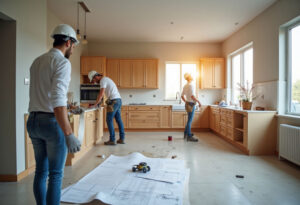Kitchen flooring plays a crucial role in a home’s functionality, aesthetics, and long-term performance. As one of the busiest areas in any home, the kitchen is constantly exposed to spills, heat, moisture, and daily foot traffic. That’s why exploring the durable kitchen flooring options 2025 has become essential for homeowners looking to combine style with resilience. Choosing the right flooring ensures longevity, easy maintenance, and a design that enhances your kitchen’s overall appeal.
In 2025, homeowners are prioritizing flooring options that offer durability, water resistance, and aesthetic appeal. From classic choices like hardwood and tile to modern innovations like luxury vinyl plank (LVP) and waterproof laminate, this guide explores the best flooring options for a long-lasting kitchen.
Key Topics Covered in This Article
Durable Kitchen Flooring Options 2025: Hardwood for Timeless Beauty and Strength
Why Hardwood Remains a Popular Choice
Hardwood flooring has been a top choice for decades, offering:
- Aesthetic appeal that adds warmth and elegance.
- Longevity, as solid hardwood can last over 50 years with proper care.
- Refinishing options, allowing homeowners to restore its look multiple times.
Challenges of Hardwood in Kitchens
While hardwood is durable, it is not naturally water-resistant. Exposure to moisture and spills can cause:
- Warping or swelling if water is not cleaned quickly.
- Scratches and dents from heavy foot traffic and dropped items.
- Higher maintenance, as it requires regular sealing to prevent damage.
Pro Tip: Opt for engineered hardwood with a water-resistant core to get the look of hardwood with added durability.
Luxury Vinyl Plank (LVP): Waterproof and Stylish
The Rise of LVP as a Kitchen Flooring Favorite
Luxury vinyl plank (LVP) is an affordable, water-resistant alternative to hardwood. It mimics natural wood and stone textures while offering:
- 100% waterproof properties, making it ideal for kitchens.
- Scratch and stain resistance, ensuring long-lasting durability.
- Soft, comfortable surface, reducing strain on feet and joints.
Considerations Before Choosing LVP
While LVP is durable, lower-quality options may be prone to:
- Fading in direct sunlight, requiring UV protection for kitchens with large windows.
- Potential denting from heavy appliances or furniture.
- Shorter lifespan compared to tile or hardwood (15-25 years).
Pro Tip: Choose rigid core LVP for extra durability and enhanced stability.
Ceramic and Porcelain Tile: Classic and Water-Resistant
Why Tile is a Top Choice for Kitchen Durability
Ceramic and porcelain tiles offer unmatched resistance to water, stains, and heat, making them ideal for kitchens. Benefits include:
- Waterproof properties, perfect for spill-prone areas.
- Heat resistance, ensuring durability near stoves and ovens.
- Extensive design options, with patterns ranging from classic to modern.
Downsides of Tile Flooring
Despite its durability, tile has a few drawbacks:
- Hard surface, which can be uncomfortable for prolonged standing.
- Grout maintenance, as grout lines can stain if not sealed properly.
- Can feel cold, requiring underfloor heating for warmth in winter.
Pro Tip: Opt for porcelain tile over ceramic—it’s denser, more durable, and less porous.
Waterproof Laminate Flooring: Budget-Friendly Durability
Why Laminate Flooring is Gaining Popularity
Laminate flooring has evolved with waterproof technology, making it a viable option for kitchens. It offers:
- Affordable pricing compared to hardwood or tile.
- Scratch-resistant surface, ideal for busy households.
- Easy installation with click-and-lock planks.
Limitations of Laminate in Kitchens
- Not all laminate is waterproof, so choosing a high-quality waterproof option is essential.
- Prone to swelling if water seeps into the seams.
- Cannot be refinished like hardwood.
Pro Tip: Look for “waterproof-rated laminate” for kitchen use and seal edges properly.
Natural Stone Flooring: Elegant and Long-Lasting
The Appeal of Stone in High-End Kitchens
Natural stone, including granite, slate, travertine, and marble, adds luxury and durability to any kitchen. Key benefits:
- Extremely durable, lasting decades with proper maintenance.
- Resistant to heat and heavy impact.
- Each tile has a unique natural pattern, enhancing aesthetic appeal.
Challenges of Natural Stone Flooring
Despite its beauty, stone flooring comes with challenges:
- Higher costs, making it one of the most expensive options.
- Porous nature, requiring sealing to prevent stains and moisture absorption.
- Cold and hard underfoot, making rugs or heated floors a consideration
Pro Tip: Choose slate or granite over marble—they are less porous and require less maintenance.
Cork Flooring: Sustainable and Comfortable
Why Cork is a Great Choice for Kitchens
Cork is an eco-friendly, comfortable flooring option known for:
- Soft, cushioned surface, reducing fatigue when standing.
- Natural antimicrobial properties, preventing mold and bacteria buildup.
- Excellent sound insulation, keeping kitchens quieter.
Potential Drawbacks of Cork Flooring
- Not fully waterproof, requiring a protective sealant.
- Can dent under heavy furniture, needing furniture pads.
- Fades over time in direct sunlight, requiring UV protection.
Pro Tip: Opt for pre-sealed cork flooring to enhance durability in high-moisture areas.
Bamboo Flooring: Eco-Friendly and Durable
Why Bamboo is a Sustainable Kitchen Flooring Choice
Bamboo flooring has become a popular alternative to hardwood due to its sustainability and durability. It offers:
- Rapid renewability, as bamboo grows much faster than hardwood trees.
- High strength and hardness, making it resistant to daily wear.
- A modern, sleek aesthetic that fits contemporary kitchens.
Challenges of Bamboo Flooring in Kitchens
- Not fully waterproof, meaning spills must be wiped up quickly.
- Can scratch easily, especially in high-traffic areas.
- Humidity-sensitive, requiring proper sealing to prevent warping.
Pro Tip: Choose strand-woven bamboo flooring, which is denser and more moisture-resistant than traditional bamboo.
Concrete Flooring: Industrial-Style Durability
Why Concrete is a Great Choice for Modern Kitchens
Concrete flooring is a trendy, highly durable option used in industrial-style and modern kitchens. Its key benefits include:
- Extremely durable, resistant to scratches, dents, and stains.
- Customizable finishes, such as polished, stained, or textured.
- Low maintenance, requiring only occasional sealing.
Downsides of Concrete Flooring
Despite its strength, concrete flooring presents some challenges:
- Hard and unforgiving, making standing for long periods uncomfortable.
- Can develop cracks over time, especially if not sealed properly.
- Cold surface, requiring rugs or heating solutions in winter.
Pro Tip: Use radiant heating under concrete floors to improve comfort and warmth in colder climates.
Rubber Flooring: Shock-Absorbent and Slip-Resistant
Why Rubber is an Excellent Choice for Busy Kitchens
Rubber flooring is gaining popularity for high-traffic kitchens, offering:
- Slip-resistant properties, making it safer for homes with kids or elderly family members.
- Shock-absorbing comfort, reducing strain on feet and joints.
- Water and stain resistance, making cleaning effortless.
Limitations of Rubber Flooring
While durable, rubber flooring may not be for everyone due to:
- Limited design variety, as it often has a commercial look.
- Can develop scuff marks, requiring occasional buffing.
- May have a rubbery odor initially, which fades over time.
Pro Tip: Choose textured rubber flooring to enhance grip and prevent slipping in wet areas
Engineered Wood: A Better Alternative to Solid Hardwood
Why Engineered Wood Works Well in Kitchens
Engineered wood is a layered alternative to solid hardwood, offering:
- Greater moisture resistance, making it less likely to warp.
- A real wood top layer, maintaining an authentic hardwood look.
- Easier installation, with click-and-lock or glue-down options.
Potential Drawbacks of Engineered Wood
- Cannot be refinished as many times as solid hardwood.
- Higher cost than vinyl or laminate.
- Quality varies, so choosing a thick wear layer is essential.
Pro Tip: Opt for engineered wood with a thick veneer (at least 3mm) for better longevity and durability.
Terrazzo Flooring: Stylish and Ultra-Durable
Why Terrazzo is Making a Comeback
- Unmatched durability, lasting decades with proper care.
- A stunning, customizable look, with a range of colors and patterns.
- Resistant to stains, moisture, and heavy foot traffic.
- Unmatched durability, lasting decades with proper care.
- A stunning, customizable look, with a range of colors and patterns.
- Resistant to stains, moisture, and heavy foot traffic.
Considerations Before Choosing Terrazzo
While durable, terrazzo has a few downsides:
- High initial cost, making it one of the most expensive flooring options.
- Cold and hard underfoot, requiring rugs for comfort.
- Requires periodic resealing to maintain its appearance.
Pro Tip: Choose epoxy-based terrazzo, which is more lightweight and flexible than traditional cement terrazzo.
Linoleum Flooring: A Retro Yet Resilient Choice
Why Linoleum is Still a Smart Option
Linoleum has been used in kitchens for decades and is making a sustainability-driven comeback. Its benefits include:
- Eco-friendly composition, made from natural materials like linseed oil and cork.
- Soft, cushioned surface, providing underfoot comfort.
- Affordable and DIY-friendly, with easy installation.
Downsides of Linoleum Flooring
- Prone to dents and scratches from heavy appliances.
- Requires sealing to prevent moisture absorption.
- May discolor over time, especially in areas exposed to sunlight.
Pro Tip: Look for “water-resistant linoleum” with a protective coating to improve longevity in kitchen environments.
Conclusion
Selecting the right kitchen flooring is a balance between durability, aesthetics, and practicality. The best option depends on your budget, lifestyle, and maintenance preferences.
Best Choices for Different Needs
✔ Most durable: Porcelain tile, natural stone, concrete.
✔ Most water-resistant: LVP, porcelain tile, waterproof laminate.
✔ Best for comfort: Cork, rubber, linoleum.
✔ Best for budget: LVP, laminate, linoleum.
Looking for expert kitchen flooring installation? Contact JF Fuentes General Construction for professional flooring services in Maryland, Virginia, and Washington DC!
Frequently Asked Questions
What is the most durable flooring option for kitchens?
Porcelain tile and natural stone are the most durable flooring options due to their resistance to scratches, moisture, and high traffic. Luxury vinyl plank (LVP) and engineered wood also offer long-lasting durability with better comfort.
What is the best waterproof flooring for kitchens?
Luxury vinyl plank (LVP), porcelain tile, and waterproof laminate are the best waterproof options. These materials resist spills and humidity, making them ideal for high-moisture environments.
Is hardwood flooring good for kitchens?
Solid hardwood is not ideal for kitchens due to its susceptibility to water damage, but engineered hardwood is a better alternative, offering moisture resistance while maintaining the beauty of real wood.
What is the easiest kitchen flooring to clean?
Tile, LVP, and sealed concrete are the easiest kitchen floors to clean. They resist stains and spills, requiring only regular sweeping and occasional mopping.
How do I choose the best kitchen flooring for my home?
Consider the following factors:
- Durability (for high-traffic areas)
- Water resistance (for spill-prone kitchens)
- Ease of maintenance
- Budget (luxury options vs. affordable alternatives)
- Aesthetic preference
What are the best flooring options for kitchens with pets?
Scratch-resistant and water-resistant options like LVP, tile, and concrete are best for pet-friendly kitchens. They withstand claw marks and frequent spills better than wood or laminate.
Can I install kitchen flooring myself?
Some flooring options, like LVP, laminate, and linoleum, are DIY-friendly with click-and-lock installation. However, materials like tile, hardwood, and natural stone require professional installation for best results.
How do I maintain my kitchen flooring?
- Sweep daily to remove dirt and debris.
- Use gentle cleaning solutions to avoid damaging surfaces.
- Seal porous materials like stone and grout periodically.
- Use rugs or mats in high-traffic areas to reduce wear.
What are the best budget-friendly kitchen flooring options?
LVP, waterproof laminate, and linoleum offer affordable yet durable solutions for kitchens. These materials mimic the look of high-end flooring without the high price tag.
What are the top kitchen flooring trends for 2025?
- Eco-friendly materials like bamboo and cork.
- Matte-finish tiles for a sleek, modern look.
- Bold geometric and terrazzo patterns.
- Waterproof and stain-resistant flooring innovations.





